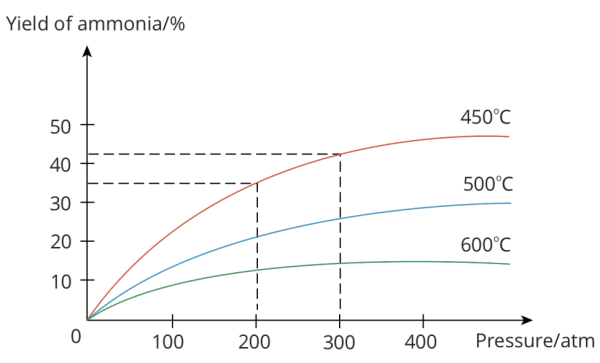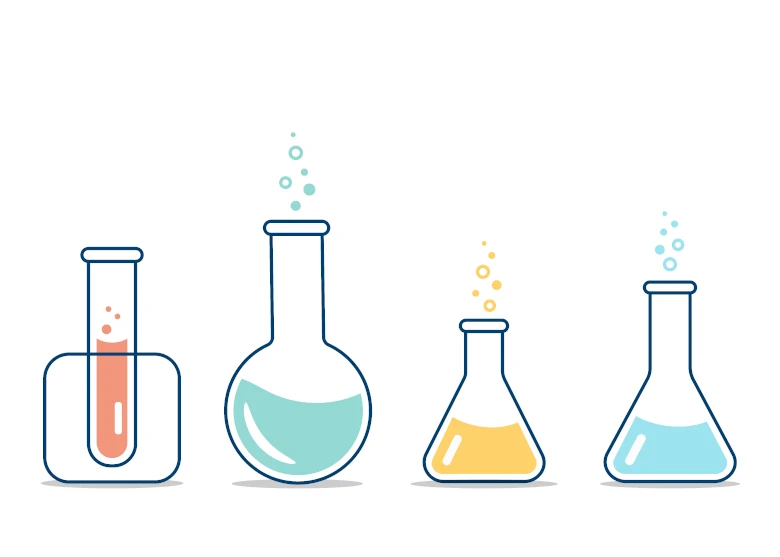Ammonia
In the following article we will learn about Ammonia. These are the learning outcomes:
- Describe the use of nitrogen, from air, and hydrogen, from the cracking of crude oil, in the manufacture of ammonia.
- Describe the essential conditions for the manufacture of ammonia by the Haber process.
- Describe the displacement of ammonia from its salts.
This article is written to aid the students of the Upper Secondary Chemistry class.
Reversible vs Irreversible Reaction
An irreversible reaction is a reaction that proceeds in one direction only. The products do not react together to reform the reactions.
For Example:
The combustion of methane gas is irreversible.
\(\small \textsf{methane + oxygen} \xrightarrow{\quad}{} \textsf{carbon dioxide + water vapour}\)
\(\small \mathsf{CH_4 (g) + 2O_2 (g)} \xrightarrow{\quad}{} \mathsf{CO_2 (g) + 2H_2O (g)}\)
When methane goes under combustion, carbon dioxide and water vapour are produced. Under normal conditions, the products are stable and hence would not react spontaneously to give methane and oxygen again. So, the combustion of methane proceeds in one direction and is irreversible.
A reversible reaction is a reaction that proceeds in both directions (forward and backward) at the same time.
Examples:
- Decomposition of ammonium chloride
Ammonium chloride, NH₄Cl, is a white solid, which decomposes upon heating to give ammonia gas, NH₃, and hydrogen chloride gas, HCl.
\(\small \mathsf{NH_4Cl} \xrightarrow{\quad\quad}{} \mathsf{NH_3 + HCl}\)
Upon cooling, these two gases react to form ammonium chloride again.
\(\small \mathsf{NH_3 + HCl} \xrightarrow{\quad\quad}{} \mathsf{NH_4Cl}\)
- Ionisation of weak acid
A weak acid, such as ethanoic acid, CH₃COOH, ionises partially in water to form CH₃COO– and H+ ions. At the same time, some of these ions reassociate to form CH₃COOH. Both reactions occur simultaneously, so after some time, an equilibrium is reached.
- Heating of hydrated copper(II) sulfate crystals
Upon heating the blue crystals of hydrated copper(II) sulfate (CuSO4.5H2O), we get white anhydrous copper(II) sulfate (CuSO4). The water of crystallisation has been removed. When white anhydrous copper(II) sulfate is rehydrated by adding water, the blue crystals of hydrated copper(II) sulfate can be obtained.
We will use a double arrow sign (⇌) to indicate a reversible reaction.

The reaction from left to right is the forward reaction, while the reaction from right to left is the backward reaction.
Take the decomposition of ammonium chloride as an example:
\(\small \mathsf{NH_Cl} \rightleftharpoons \mathsf{NH_3 + HCl}\)
The forward reaction involves the decomposition of ammonium chloride to produce ammonia and hydrogen chloride gas. The backward reaction involves the ammonia and hydrogen chloride gas reacting to form ammonium chloride.
One of the reversible reactions that we will be studying in greater details is the manufacturing of ammonia in the Haber process.
Haber Process
Ammonia is an important raw material in the manufacture of fertilisers. Ammonia can also be made into nitric acid and household cleaning agents. Large-scale ammonia is manufactured in the industry by the Haber process, discovered by and named after a German chemist called Fritz Haber.
The raw materials for the Haber process are nitrogen and hydrogen. Nitrogen is obtained from the fractional distillation of liquid air. Hydrogen is obtained from the cracking of crude oil (or petroleum).
Conditions For Haber Process
\(\small \textsf{nitrogen + hydrogen} \rightleftharpoons \textsf{ammonia}\)
\(\small \mathsf{N_2 + 3H_2} \rightleftharpoons \mathsf{2NH_3}\)
Considerations
- At room temperature and pressure, nitrogen and hydrogen do not react. So, at what temperature and pressure should the Haber process be carried out?
- The reaction to produce ammonia is reversible. Some of the ammonia formed will decompose and convert back to nitrogen and hydrogen. How can the maximum yield of ammonia be achieved?
It is therefore important to control the conditions like pressure and temperature in order to achieve the maximum yield of ammonia at a minimum cost.
Let us look at how these conditions were chosen closely.

The figure above shows the yield of ammonia at different temperatures and pressures.
How is the optimal temperature for the manufacture of ammonia chosen?
- When the temperature is lower, the yield of ammonia is higher.
- However, at a lower temperature, the speed of the reaction will be slower.
- Thus, a temperature of 450℃ is chosen as a compromise between maximum yield and speed of reaction.
How is the optimal pressure for the manufacture of ammonia chosen?
- At higher pressure, the yield of ammonia is higher. The speed of reaction will also be higher.
- However, strong pipes and containment vessels have to be built to withstand the higher pressure. It is very expensive to build a high-pressure chemical plant.
- Thus, a pressure of 25 atm is chosen as a compromise between yield and cost.
Even with a high pressure of 25 atm and a relatively high temperature of 450℃, the reaction is still slow. Hence, iron is used as a catalyst to speed up the reaction.
Recall:
What are the characteristics of a catalyst?
- Only a small amount of a catalyst is required to speed up the reaction.
- A catalyst remains chemically unchanged at the end of the reaction.
- A catalyst is very selective in its action.
- A catalyst is not used up during the reaction.
How does a catalyst speed up a reaction?
A catalyst provides an alternative pathway with a lower activation energy for the reaction to proceed. More reacting particles have energy equal to or greater than the activation energy (Ea). The frequency of effective collisions increases. Hence, the speed of the reaction increases.
Overview Of Haber Process

Image Source: bbc.co.uk
- Nitrogen and hydrogen are mixed in the ratio of 1:3 by volume.
- These gases are compressed to 250 atm in the compressor.
- The pressurised gases are passed over finely divided iron at 450℃ in the catalyst chamber.
- The mixture of unreacted nitrogen and hydrogen, together with ammonia enter a cooling tank. The ammonia gas is condensed to form liquid ammonia.
- Unreacted nitrogen and hydrogen are recycled by being pumped back into the converter for further reaction.
Question 1:
Which best describes the sources of nitrogen and hydrogen for the Haber process?
| Nitrogen | Hydrogen | |
|---|---|---|
| (A) | Decomposition of ammonia | Fractional distillation of liquid air |
| (B) | Fractional distillation of liquid air | Cracking of crude oil |
| (C) | Decomposition of ammonia | Electrolysis of water |
| (D) | Electrolysis of sodium nitrate | Fractional distillation of liquid air |
Solution:
(B)
Explanation:
Nitrogen is obtained from the fractional distillation of liquid air.
Hydrogen is obtained from the cracking of crude oil (or petroleum).
Question 2:
Which of the following options shows the correct conditions for the production of ammonia via the Haber process?
| Temperature / º C | Pressure /atm | Catalyst | |
|---|---|---|---|
| (A) | 250 | 50 | Iron |
| (B) | 250 | 250 | Nickel |
| (C) | 450 | 50 | Nickel |
| (D) | 450 | 250 | Iron |
Solution:
(D)
Question 3:
In the Haber process, nitrogen and hydrogen react to form ammonia. Which of the following is/are correct?
- Ammonia is liquefied after being formed.
- Hydrogen is obtained from fractional distillation of air.
- The reaction to make ammonia is reversible.
- The reaction involves the use of a compound of transition metal.
Choose the correct option:
- I and III
- II and III
- II, III and IV
- All of the above
Solution:
(A) I and III
Explanation:
The Haber process is a reversible reaction as some of the ammonia formed is unstable, which decomposes readily back into its reactants.
As the reaction mixture (containing nitrogen, hydrogen and ammonia) leaves the converter and enters the cooler and the temperature decreases, by having a higher boiling point than hydrogen gas and nitrogen gas, the ammonia gas will condense first to form liquid ammonia. Thus, it can be collected and removed for storage. The unreacted nitrogen and hydrogen gas are pumped back into the converter for further reaction.
The reaction uses the transition metal, iron, as the catalyst, and not a compound of it.
Question 4:
If the reaction between nitrogen and hydrogen is not a reversible reaction, then __________.
- the yield of ammonia would increase because ammonia will not decompose back into its elements
- the yield of ammonia would decrease because there is no recycling of unreacted hydrogen and nitrogen taking place
- the yield of ammonia would remain the same if the conditions are kept the same
- any temperature will be sufficient for all nitrogen and hydrogen to be converted into ammonia
Solution:
(A) the yield of ammonia would increase because ammonia will not decompose back into its elements
Explanation:
The reaction between hydrogen and nitrogen to form ammonia in the Haber process is a reversible one. This means that some of the ammonia formed may revert back to nitrogen and hydrogen. This is why the percentage yield of ammonia is approximately 15%.
If the reaction is not reversible, then we will not have the ammonia formed that decomposed back into nitrogen and hydrogen gas. Hence, the yield of ammonia will be higher.
Displacement Of Ammonia From Its Salts
When an ammonium salt is heated with an alkali, ammonia is displaced from the salt.
For Example:
ammonium chloride + sodium hydroxide → ammonia + water + sodium chloride
\(\small \mathsf{NH_4Cl \,(s) + NaOH \,(aq)} \xrightarrow{\quad}{} \mathsf{NH_3 \,(g) + H2O \,(l) + NaCl \,(aq)}\)
Question 5:
A farmer uses ammonium nitrate to fertilise his soil, then adds calcium hydroxide to neutralise excess acid in the soil. Why is this not a good idea?
- Ammonium hydroxide will be precipitated from the soil.
- The addition of calcium hydroxide will cause the soil to turn alkaline.
- Calcium hydroxide will react with ammonium nitrate to release nitrogen molecules.
- Calcium hydroxide will react with ammonium nitrate to release ammonia gas.
Solution:
(4) Calcium hydroxide will react with ammonium nitrate to release ammonia gas.
Explanation:
Ammonium nitrate will react with calcium hydroxide to produce ammonia gas. The ammonia gas produced in this reaction escapes into the atmosphere. This causes the loss of nitrogen from fertilisers already added to the soil by farmers, which are needed for the plants to grow well.
Conclusion
In this article, we learned about reversible and irreversible reactions. We also understood the essential conditions for the manufacture of ammonia by the Haber process. The details covered in the article are aimed to help the students of the Upper Secondary Chemistry class.
| Continue Learning | |
|---|---|
| Metals | Introduction to Organic Chemistry |
| Alcohols | Speed of Reaction |
| Electrolysis | Energy Changes |
| Ammonia | Alkanes |
| Alkenes | Carboxylic Acids |


 SG
SG  VN
VN 
















